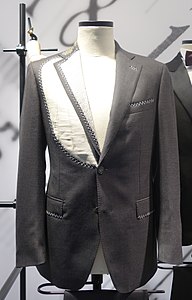Pricking (tailoring)
In tailoring , piquing (from French piquer = to pierce) refers to a sewing technique for permanent and elastic incorporation of the wadding into the coat or jacket lapel , either by hand or with single-purpose machines , in order to give it shape and firm hold. At least in industry today, this work is largely replaced by front fixation . A well-executed piquing allows the lapel to roll out elegantly onto the button.
The application of intermediate materials to the leather side of furs is also referred to as pricking in skinning .
Pricking in skinning

Pricking stitches are also set in skinning , the stitch can be done by hand or on a pricking machine (also known as a blind stitch machine ). The stitches are drawn across.
Pricking, also known as stapling, is intended to protect the leather, which is deliberately left in the fur tanning process, from stretching when the item of clothing is used. In addition, the applied material, especially in the case of old or sensitive leather, reduces the risk of the hides tearing; the seams are particularly at risk. Also by pricking, if necessary over the pricking material, an additional warming material such as cotton wool, down fleece or other modern synthetics can usually be applied in a further operation .
Light- leather fur types endangered by tearing are, for example, feh , galjak broadtail or hamsters . Mink , broadtail, Persian and nutria , among others , expand easily . Reconditioned old furs or parts made from pieces of fur may be rotten in the leather or endangered .
The body and sleeves can be covered over the whole or part of the surface with special pricking fabrics, nettle or batiste. Firmer or shaping materials such as linen or horsehair are pricked on the front edges, the lapels and the lower collar . All the ingredients used for this have a plain weave , as it has the least stretch of all types of weave .
Until around the 1970s, fur, with the exception of strong types of fur such as calfskin or horse skin , was actually always pricked out over the entire surface or at least from above to below the buttocks. In the meantime, the focus has shifted more to reducing weight as much as possible. Today the furrier usually only covers the edges, the collar and particularly stressed or endangered parts as well as reworked furs, if deemed necessary.
A linen binding fabric can also be stretched diagonally. Therefore, the pricking fabric must be cut at right angles to the front edges and the center of the back in the course of the thread, so that the greatest possible protection against overstretching in length and width occurs.
The attached fabric is worked up in a blind stitch with a slightly different thread guide. The part lies flat on the work table. The first puncture is made from right to left for right-handers. The drawn thread is led down a little diagonally, whereupon another stitch is made from right to left. Depending on the sensitivity, the distance between the stitches is 1 to 3 cm. According to the textbook, the next row of stitches is placed next to it at a distance of 1 to 1½ cm. In practice, the distances are often much larger today, and the wadding is also applied with much more generous stitches. Particularly fine pricking work, such as the round pricking of horsehair on lapels, is carried out in the same way as in tailoring.
Today, the intermediate ingredients are applied with the pricking machine as far as possible. Very fine or sensitive leathers cannot be pricked out with it, there is a risk that the needle will pull the thread through to the hair side or that the leather will tear instead of stretching around the needle, which would destroy the purpose of greater durability of the leather.
After sewing the fur together, the pricking fabric is overcast. The previously rolled out facon seams are covered by the fabric pricked onto the parts, either by hand with a basting seam or with the pricking machine.
In the manufacture of clothing in particular , the intermediate materials ( fixing materials ) are often ironed on using fixing presses. Since there is a risk of the garment becoming stiffened that is no longer desired, valuable furs, at least, are now usually pricked out again.
Literature, web links
- Eva Laue: The Staffieren I . 2nd improved edition. Hermelin Verlag Dr. Paul Schöps, Berlin / Frankfurt am Main / Leipzig / Vienna 1972.
- How to Sew a Pickstitch (English)
- The technique of the furrier (PDF; 788 kB)
Individual evidence
- ↑ Prick out. In: Alfons Hofer: Textile and Model Lexicon . Volume 2, 7th edition. Deutscher Fachverlag, Frankfurt am Main 1997, ISBN 3-87150-518-8 .


